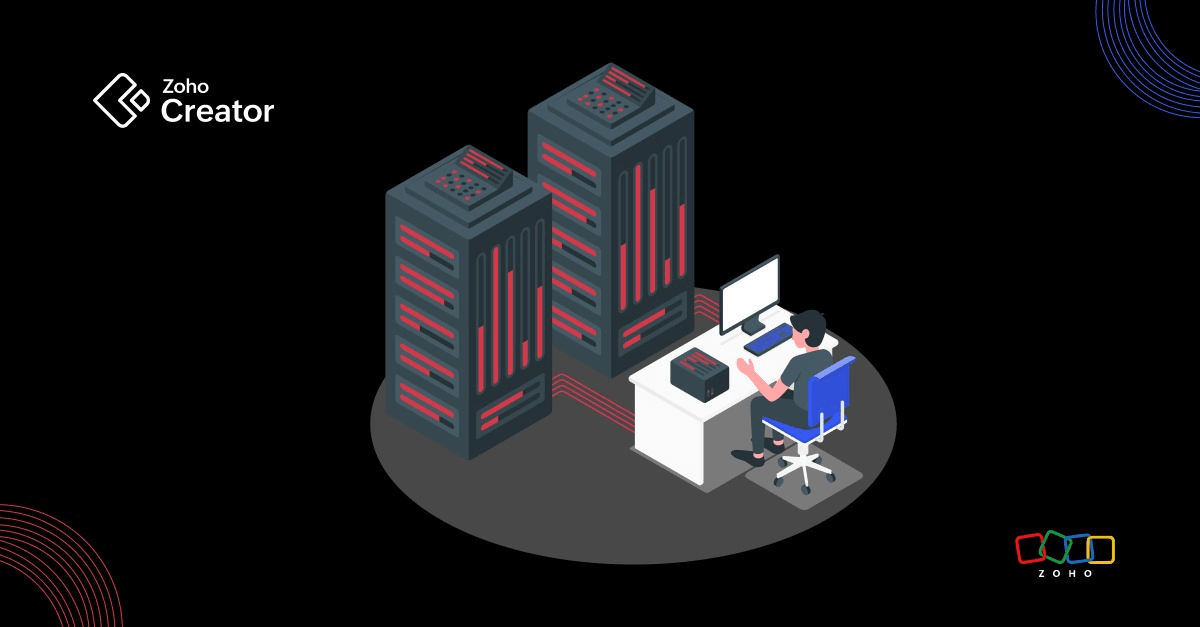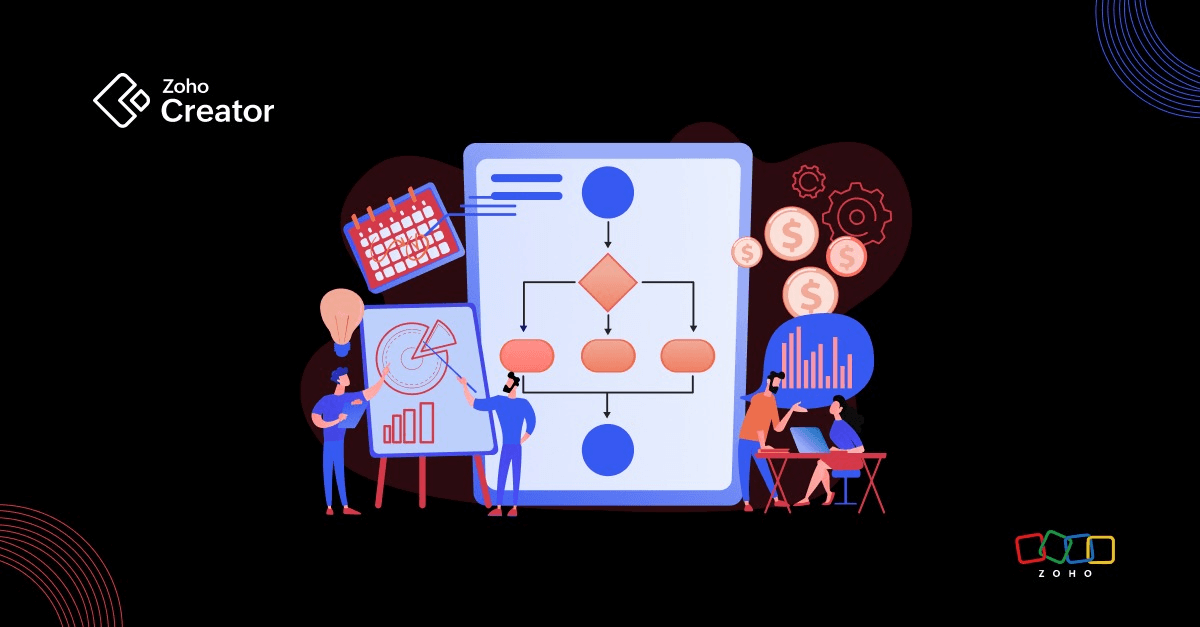- HOME
- Know Your Tech
- A guide to digital transformation with scalable agile solutions
A guide to digital transformation with scalable agile solutions
- Last Updated : July 25, 2025
- 498 Views
- 12 Min Read
TL;DR: Digital transformation doesn’t have to mean overhauling everything at once. Scalable agile solutions allow businesses to modernize step by step—adapting to change, reducing risk, and improving collaboration without burning out teams. By combining agile principles with automation, cloud tools, and iterative delivery, organizations can stay flexible, align teams around business goals, and respond faster to shifting demands. Whether it’s automating workflows, enabling continuous improvement, or integrating DevOps and predictive insights, agile transformation helps businesses scale sustainably and drive real outcomes—without the drag of outdated methods.
The pace of change in today's work environment can be overwhelming. New technologies, rising expectations, and constant market shifts often leave teams stretched thin and unsure of where to focus. Many organizations aren't held back by a lack of ambition but by the size and complexity of the changes they face.
Agile solutions offer a structured yet flexible way to manage that complexity. Instead of attempting to overhaul everything at once, agile solutions help teams break considerable challenges into smaller, more manageable steps. This makes adapting, learning, and building meaningful progress easier, without falling into the trap of overplanning or reacting too late.
According to the 17th State of Agile Report, 71% of organizations utilize Agile methodologies in their software development lifecycle. This growing adoption shows how effective Agile is in meeting the challenges businesses face today. In this blog, you'll learn how these solutions can reduce friction, support continuous improvement, and help your team stay focused by taking one step at a time.
What is digital transformation?
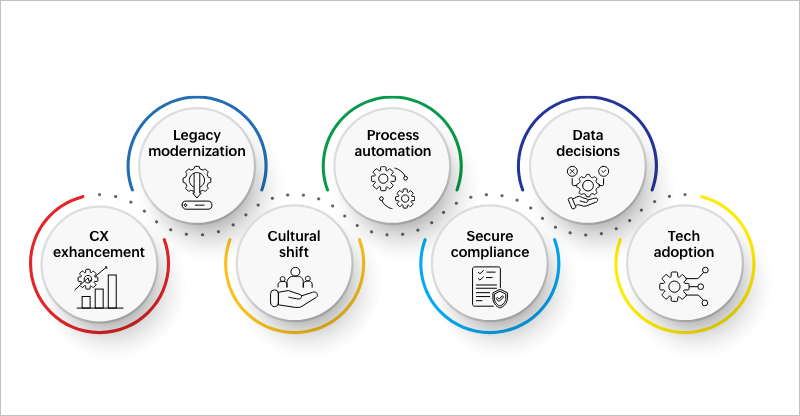
Digital transformation is the strategic adoption of digital technologies to fundamentally improve how an organization operates, delivers services, and creates value. It's not just about using new tools; it involves rethinking processes, culture, and infrastructure with a digital-first mindset.
Here’s what digital transformation typically includes:
Modernizing legacy systems
Modernizing legacy systems refers to replacing or upgrading outdated software, infrastructure, and platforms to improve performance, security, and scalability. This often includes cloud migration, API integration, and transitioning from monolithic systems to microservices.
Process automation
Process automation digitizes manual workflows to increase speed, accuracy, and efficiency. This may involve robotic process automation (RPA), workflow tools, or AI-powered decision-making that reduces repetitive tasks.
Data-driven decision-making
Data-driven decision-making uses real-time data and analytics to guide strategy, operations, and customer engagement. This includes building data lakes, implementing dashboards, and applying predictive analytics and machine learning models.
Customer experience enhancement
Customer experience enhancement is about improving customer interactions across digital channels using tools like CRM systems, mobile apps, user experience (UX) design, chatbots, and omnichannel engagement strategies.
Cultural and organizational change
Cultural and organizational change involves encouraging a digital mindset across teams by promoting innovation, collaboration, and continuous learning. This often requires leadership alignment, new training programs, and the adoption of agile ways of working.
Cybersecurity and compliance
Cybersecurity and compliance is focused on ensuring that digital systems meet modern security standards and regulatory requirements. Key areas include identity and access management, data protection, encryption, and ongoing risk assessment.
Adoption of emerging technologies
Adopting emerging technologies is about exploring and implementing technologies—like artificial intelligence, blockchain, the internet of things (IoT), and augmented or virtual reality—wherever they align with strategic goals and deliver measurable outcomes.
While digital transformation focuses on rethinking technology, processes, and culture, the real challenge often lies in how change is put into action. Agile digital transformation addresses this need by providing a flexible and iterative approach that helps teams implement improvements more effectively and with less risk.
What is agile digital transformation?
Agile digital transformation is the application of agile methodologies to an organization’s digital modernization strategy. Unlike traditional transformation models, which often treat the process as a single, large-scale project, agile digital transformation breaks the process into smaller, iterative steps.
Each step is designed, tested, and optimized based on real-time feedback, enabling continuous refinement throughout the lifecycle. This approach not only ensures rapid response to changing business and technical requirements but also maintains flexibility in execution.
How does it differ from traditional digital transformation?
Traditional digital transformation follows a more linear, waterfall-based methodology, whereas agile digital transformation focuses on incremental development and continuous feedback loops. The key differences between traditional and agile digital transformation include:
| Traditional digital transformation | Agile digital transformation |
Approach | Linear, waterfall-based | Iterative, flexible |
Execution | One-time, large-scale implementation | Incremental releases in short cycles (sprints) |
Planning | Long-term roadmap (multiple years) | Short-term cycles with continuous planning and adjustments |
Adaptability | Minimal room for adjustments once execution starts | Frequent feedback loops and adjustments at each sprint phase |
Risk management | High risk of obsolescence due to fixed, inflexible plans | Reduced risk due to continuous testing and refinement |
Completion | Fixed end point, often outdated by completion | Ongoing process, continuously evolving to meet business needs |
While traditional digital transformation follows a rigid, long-term path, Agile allows businesses to stay flexible, adapt quickly to market changes, and continuously improve. With Agile, your business can adapt to change, not fear it.
Benefits of flexible agile solutions in digital transformation
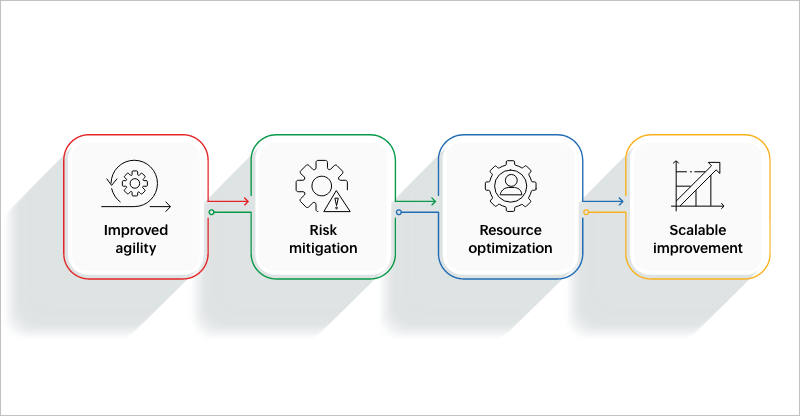
According to the Gartner 2025 CIO Survey, only 48% of digital transformation initiatives meet or exceed their targeted business outcomes. This highlights the need for a more flexible, scalable approach to digital transformation to avoid the pitfalls of traditional, static models.
The adoption of scalable agile solutions in digital transformation offers several technical and operational advantages:
Improved agility: Agile's iterative model enables your organization to rapidly adjust to technical requirements and business condition changes. This speed of adaptation is essential in modern, dynamic environments where market demands can shift quickly.
Risk mitigation: By implementing gradual changes and validating them in each cycle, you significantly reduce the risk of large-scale failures. This is particularly important for complex, enterprise-level systems that are costly to change after full deployment.
Optimized resource allocation: Agile solutions allow you to prioritize resources and features based on immediate technical and business needs. This reduces wasted effort and focuses investments on high-value, high-priority areas.
Continuous improvement and scalability: Each sprint contributes to continuous system improvement, utilizing real-time data to inform future phases.
As your organization grows and its needs evolve, digital tools continue to adapt, ensuring alignment with business objectives and maximizing long-term value.
Key components of scaled agile for digital transformation
Digital transformation requires more than just adopting new technologies, it's about aligning teams, processes, and leadership to deliver continuous value. Scaled agile practices can drive this transformation by improving efficiency, fostering collaboration, and ensuring that teams stay aligned with evolving business goals. To successfully scale agile methodologies, certain key components must be implemented to ensure that your organization can maintain flexibility and deliver results consistently.
Lean-agile leadership for promoting agile principles
Agile transformation begins with strong leadership. As a CEO or IT director, instilling lean-agile principles promotes a culture of continuous improvement, customer-centricity, and value delivery.
Key responsibilities of lean-agile leaders:
Enable decision-making at all levels.
Foster a mindset of learning and adaptability.
Lead by example to reinforce agile values.
Leading with these principles enables teams to innovate and perform efficiently, contributing to successful digital transformation.
Agile release trains for delivering incremental value
Agile release trains (ARTs) bring together multiple teams to work towards shared goals and deliver value step by step. It helps scale agile practices and break large initiatives into manageable pieces.
Key benefits of ARTs:
Coordinates multiple teams effectively
Ensures timely delivery of value
Breaks projects into smaller, manageable tasks
ARTs ensure consistent, predictable results, aligning with your digital transformation objectives.
Program increment planning for team alignment and priority setting
Program increment (PI) planning aligns all teams within the ART on shared objectives, sets priorities, and maps out work for the next increment. This ensures clear focus and minimizes silos.
Why PI planning matters:
Clear visibility on goals and timelines
Increased alignment and collaboration
Prioritizes tasks based on business value
PI planning ensures your digital transformation stays focused on high-value outcomes.
Continuous delivery pipeline
A continuous delivery pipeline (CDP) automates the process of building, testing, and releasing software, enabling faster and more efficient feature delivery.
CDP capabilities include:
Accelerating release cycles
Reducing errors by automating tests and builds
Responding quickly to market and customer demands
A CDP ensures your teams deliver value quickly and efficiently.
DevOps and agile technical practices for improved software quality
Combining DevOps with agile technical practices improves collaboration and software quality. This approach supports faster, more reliable software delivery.
Key outcomes of combining DevOps with agile:
Identifies issues early in the development process
Strengthens collaboration across teams
Improves software quality through automated testing and continuous integration
DevOps and agile practices help scale agile initiatives and refine digital transformation efforts.
By integrating these key components, your organization can effectively scale agile practices, drive value delivery, and accelerate your digital transformation efforts.
Selecting and applying scaled agile frameworks
Choosing the right agile framework ensures better coordination, faster delivery, and smoother workflows. Here's a brief overview of three key frameworks: SAFe, LeSS, and DAD.
Scaled agile framework for simplified teamwork
Scaled agile framework (SAFe) is designed for large enterprises, aligning multiple teams with business goals. It organizes teams into ARTs for synchronized planning and execution. Benefits include:
Cross-team collaboration towards common goals
Clear roles and responsibilities for better accountability
Continuous delivery through ARTs
SAFe helps scale agile practices across the enterprise while ensuring efficient delivery.
Large-scale scrum for transparent and simple task management
Large-scale scrum (LeSS) extends scrum principles to larger projects, focusing on simplicity and transparency. It emphasizes:
Minimal complexity with streamlined processes
Quick iterations for faster delivery
Maintaining core scrum values
LeSS is perfect for companies seeking a lightweight framework that keeps things simple and transparent.
Disciplined agile delivery for aligning strategies across teams
Disciplined agile delivery (DAD) is a flexible framework that aligns business and technical goals across multiple teams. Key benefits include:
Comprehensive lifecycle management
Adaptability to various project types
Strategic alignment across teams
DAD is ideal for organizations with complex structures needing unified, disciplined delivery.
Choosing an agile framework is just the starting point. What truly drives change is how well you apply it across teams, processes, and priorities. The best practices below serve as guideposts to help you scale agile with focus, clarity, and measurable results.
Best practices for implementing scalable agile solutions
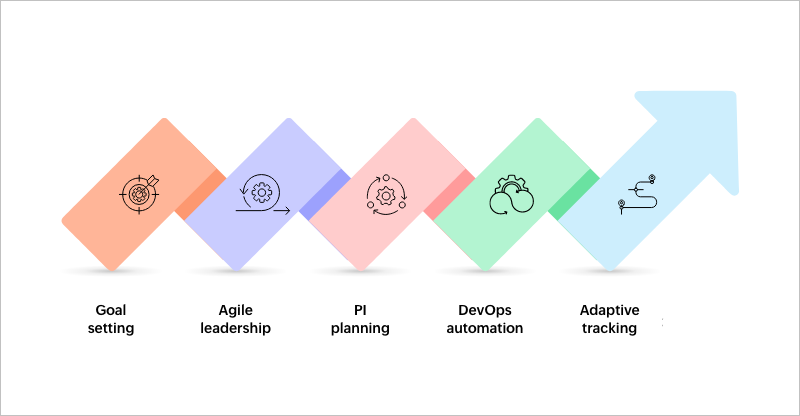
Adopting agile methodologies can greatly boost a business’s ability to stay flexible, simplify its operations, and remain responsive to shifting market demands. However, as organizations aim to scale their agile practices, it’s crucial to take a thoughtful approach. It's not just about implementing Agile—it’s about ensuring that the method fits the needs of the present and is robust enough to grow with the company’s future.
1. Define clear transformation goals
Begin by identifying specific, measurable goals for adopting agile solutions. These goals should be tied to desired outcomes, such as improving delivery speed, enhancing team collaboration, or increasing customer value. Clear direction helps guide decision-making and keeps teams aligned throughout the scaling process.
2. Build agile leadership and a change-ready culture
Agile solutions require leaders who are adaptable and can model agile principles. Build a change-ready culture that encourages collaboration, transparency, and learning from feedback. This mindset will help teams stay flexible and continuously improve.
3. Conduct program increment planning for aligned outcomes
Program increment (PI) planning helps teams align on shared objectives and priorities. It ensures everyone is on the same page, with clear deliverables and timelines. Regular PI planning sessions keep teams focused and aligned on the most critical goals.
4. Integrate DevOps and automation for simplified processes
Integrating DevOps practices and automation accelerates development and reduces manual effort. DevOps fosters collaboration between teams, while automation speeds up delivery and ensures quality. This combination allows agile solutions to scale efficiently.
5. Continuously measure progress and adapt plans with real-time data
Using real-time data to track progress ensures your agile initiatives stay on course. Regular reviews and feedback loops help identify roadblocks and adjust plans quickly. This adaptability is essential for continuous improvement and achieving business goals.
Following these practices will set your teams up to grow agile in a way that aligns with your business needs. This approach will also help you improve how you work together, stay adaptable, and keep driving growth, no matter what challenges come your way.
Overcoming digital transformation challenges with scaled agile
Scaling agile solutions during digital transformation comes with challenges, including overcoming resistance to change, managing the complexity of multiple systems and workflows, and building a culture that promotes collaboration and continuous learning. Here's how you can address these obstacles effectively.
Addressing resistance with alignment and transparency
Resistance to change is common, but can be minimized through alignment and transparency.
Communicate goals clearly: Ensure everyone understands the purpose of the transformation.
Involve key stakeholders: Engage leaders early to create ownership and reduce resistance.
Provide regular updates: Keep the team informed about progress and challenges to build trust.
This approach ensures a smooth transition by developing understanding and cooperation.
Managing complexity with structured planning
Scaling agile solutions adds complexity, which can be managed with structured planning.
Set clear objectives: Break the transformation into manageable stages.
Create a roadmap: Outline milestones, timelines, and resources.
Utilize tools: Platforms that automate workflows, like Zoho Creator, simplify processes and can significantly enhance efficiency.
This structured approach simplifies the process and keeps the team focused on key tasks.
Driving a culture of collaboration and continuous learning
Agile thrives in a culture of collaboration and continuous improvement, especially when alignment and communication across teams become barriers. To address this, consider the following solutions:
Encourage teamwork: Promote cross-department collaboration to align on goals and ensure all teams work toward common objectives.
Support knowledge-sharing: Provide regular training and learning opportunities to keep teams updated with best practices and evolving methods.
Promote adaptability: Enable teams to experiment with new approaches, helping them remain flexible and responsive to changes.
Creating a culture of collaboration and learning ensures your team stays adaptable and innovative.
To bring these strategies to life, let's look at how businesses apply scalable agile solutions to tackle industry-specific challenges.
Examples of digital transformation with scalable agile solutions
Organizations in every sector are turning to agile platforms to address real operational challenges. Whether it’s managing complex workflows, gaining clearer insight into data, or responding quickly to shifting demands, these real-world examples highlight how scalable agile solutions enable teams to work smarter, reduce delays, and maintain focus even in unpredictable conditions.
Real estate: Personalized customer experiences and agile solutions
The real estate industry involves managing various activities, from coordinating client communications to handling property documents and auction schedules. For companies like Auction Caddy, simplifying these processes is important to improve efficiency and ensure smooth operations.
Challenge: Auction Caddy faced challenges in coordinating auction schedules, managing bidding processes, and following up with clients manually, often relying on spreadsheets for tracking and scheduling.
Solution: By adopting Zoho Creator, an agile low-code platform, they were able to automate their business operations. Custom applications helped simplify auction scheduling, bidding management, and post-auction follow-ups.
Results: This allowed their small team to manage complex processes without relying on spreadsheets or manual coordination. The company saw significant improvements in accuracy and time savings, and better visibility into daily operations.
Zoho Creator helped Auction Caddy transition from manual processes to an agile, automated system, showing how agile solutions can support lean teams and complex, detail-heavy tasks.
Manufacturing: Boosting productivity with IoT and maintenance
Manufacturing companies often deal with issues like downtime and inefficiency, which can directly affect productivity. To address these challenges, many are turning to IoT devices for real-time monitoring and AI-driven predictive maintenance, helping prevent unexpected disruptions and improve overall operational performance.
By integrating IoT sensors into their production systems, companies can monitor the health of their equipment in real time, allowing for early detection of potential issues before they result in costly downtime. Predictive maintenance, powered by AI, can then analyze this data to forecast when maintenance is needed, minimizing unscheduled stoppages and enhancing the longevity of machinery.
This proactive approach to maintenance, combined with streamlined operational workflows, ensures manufacturing processes run more efficiently, helping businesses stay agile, reduce inefficiencies, and improve overall productivity.
Healthcare: Telehealth and AI diagnostics for improved care
The healthcare industry constantly faces the challenge of keeping up with increasing patient demands while maintaining quality care. For companies like Parametrics Medical, managing complex order systems and medical products was a hurdle that required a more efficient solution.
Challenge: Parametrics Medical relied heavily on spreadsheets and manual tracking for order management, leading to inefficiencies and errors.
Solution: Using Zoho Creator, Parametrics Medical developed a custom order management application. This automated and simplified the tracking of medical products, integrated clinics, distributors, and healthcare providers, and improved overall operational efficiency.
Results: The new system reduced manual work, increased productivity by 25%, and made the process more accurate. Additionally, it laid the foundation for advanced tools like WoundCare AR and the Daily WoundCare Tracker.
Zoho Creator helped Parametrics Medical move away from outdated methods and manual systems. By focusing on their specific challenges, they created a flexible, scalable tool that continues to grow with their operations.
These examples show how scalable agile solutions help businesses move away from outdated systems and manual work. By focusing on specific challenges, teams are building flexible tools that grow with them and improve day-to-day execution.
Achieve scalable growth and simplify operations with Zoho Creator
Operating a business today comes with its fair share of hurdles. Whether it's balancing multiple workflows, minimizing IT reliance, or ensuring systems remain flexible and scalable, the challenges can quickly pile up. Without a clear strategy to simplify operations and reduce manual workloads, progress can stall, making it harder to adapt and compete in an ever-changing market. Without a straightforward way to simplify tasks and cut back on manual effort, growth stalls and productivity drops, making it challenging to keep up with the market.
This is where Zoho Creator can make a real difference. Zoho Creator allows you to build custom applications without needing extensive coding skills or a large IT team. It automates workflows, integrates systems, and adapts as your business evolves, ensuring your operations remain agile and responsive to changing needs. With Zoho Creator, you can reduce manual tasks, improve coordination, and keep your business running efficiently, allowing you to focus on what truly matters.
Don’t let everyday challenges hold your team back. Discover how Zoho Creator can simplify your operations and help you build exactly what your organization needs without added complexity.
 Ashwin Raj S N
Ashwin Raj S NAshwin is a Growth Marketer for Zoho, with a passion for learning new things. In his spare time, he enjoys spending time with his family and friends, watching anime, and travelling.

